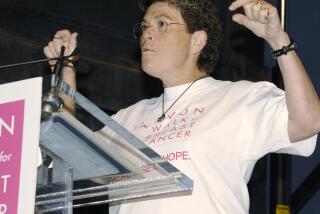A cancer that need not kill
I was a Harvard-educated doctor, yet I couldn’t save my mother from dying of an easily preventable disease. I am determined that her death will not have been in vain.
In retrospect, it’s not surprising that my mother ignored her early symptoms. She had survived by ignoring hardship her entire life. Abandoned by her mother when she was just 6 weeks old, she shuttled between the various homes of relatives. Her refuge was a makeshift bedroom -- a cot on the floor of her grandmother’s closet. Philadelphia in the 1930s was neither the time nor the place to be a poor and unwanted black child. She began working as a domestic servant when she was just 12 years old, cleaning houses and caring for children not much younger than herself. She later dropped out of school and, while still an adolescent, began having babies of her own.
My mother was ultimately able to give her five children the kind of loving home she didn’t know in childhood. And she opened her home to all those in need: pregnant girls and single mothers with nowhere to turn, strangers who had lost faith. She loved my partner and our adopted son as much as she did her own children. Instead of embittering her, the rejections in her own life had taught her to accept people as she found them.
She was so busy taking care of others that when she began having light, occasional vaginal bleeding, despite having gone through menopause, she ignored it until it grew heavier and more frequent. After an anxious trip to the doctor, tests confirmed that she had cervical cancer, caused by the human papilloma virus she had acquired years earlier.
Cervical cancer can be diagnosed with a simple Pap smear in its early stages, when it is easily eradicated. But in order for early diagnosis to happen, women must have access to healthcare and use it. And like many women, my mother was slow to seek out care, too preoccupied with the needs of others.
The cancer that started on her cervix had already spread throughout her pelvis by the time it was discovered and then quickly spread to her liver, lungs and brain.
By the time she died in my arms, I had been a doctor in Los Angeles for more than a decade. But her death from a disease that could have been stopped with early treatment persuaded me to change course. Today, I am senior fellow and director of global health at the George W. Bush Institute in Dallas. As a black gay man who is also a Democrat, some people find it ironic that I serve in such a prominent role at an institute founded by a conservative Republican president. But global health is not divided by politics; it is united by compassion and a belief that all people have value.
The Bush Institute’s flagship health program, Pink Ribbon Red Ribbon, aims to combat cervical and breast cancer in Africa and Latin America by increasing access to cancer prevention and treatment through an innovative public-private partnership. In developing countries, where Pap smears are too expensive, cervical cancer can be diagnosed by putting a few drops of vinegar on the cervix, which is then examined under a lamp. Lesions appear white and can be treated at an early stage by freezing them off.
A recent study from India showed that this simple vinegar test that costs less than $1 can reduce deaths by nearly one-third. There are also inexpensive vaccines that can prevent the viral infection entirely. We can defeat cervical cancer now in simple, cost-effective ways.
The challenge is access. To save women from cervical cancer, we must strengthen existing systems and shift care to lower-cost providers and settings that are already trusted and know how to overcome cultural barriers. We must create partnerships among governments, businesses, nonprofits, entrepreneurs and women of all ages. And, as my mother’s death taught me, we must mobilize women to recognize their risk and realize that by protecting their health, they can live to protect the ones they love.
My mother fretted in her dying days about what she saw as her lack of accomplishments: She was intelligent but uneducated. She was courageous yet lived in fear. She had done nothing with her life, she felt. She had not fulfilled her life’s mission.
I disagreed. I told her that I believed that her life’s mission was to unleash passion and purpose in the lives of those she touched. Not only had she raised five children who went on to careers in business, education and medicine; she had applied her quick mind, hearty laugh and steel backbone to helping anyone she came across who was in need. In a house that was always filled with people, she showed the world that love is what creates a family.
I couldn’t save my mother. Cervical cancer took her life, but it couldn’t kill her spirit. My mother’s spirit, and those of millions of women who have died unnecessarily, must now inspire us to fight this scourge. Together, the world can conquer cervical cancer.






